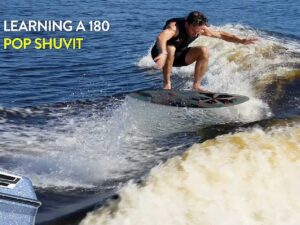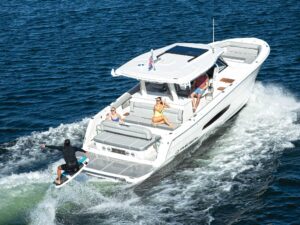Are you in a midsummer lull? You know the one – you’ve got all the tricks you can do and bust them out each day to show everyone in the boat that you can actually land moves. But every time you try a new move you flail so badly it sends you scurrying back to your tried-and-true routine.
So what do you do? If you can’t change, change your board. I’m not talking about buying a new one, but changing your old one. There’s three ways you can easily change the way your old board rides. You can tune up the rails, you can change the fin position, or you can cut the tips of the board. All can have radical effects on the board’s performance.
Move the Fin
Moving your fin isn’t anything new. People have been trying different fin positions since the beginning of wakeboarding. How fin position affects performance on a wakeboard is similar to what fin positioning does on a surfboard or even truck positioning on a skateboard. You move the fins (or trucks) away from the end of the board, and the board becomes looser. Move them out and the board tracks better. It’s a simple formula, and it works pretty much with any board. If you want to experiment with this, it’s a little trickier than it seems. You can’t just blast holes through the tail of your board. First you have to make sure the new holes you are going to drill are straight, running down the centerline of the board. Then you have to make sure the hole you drill goes straight down through the board so you don’t have to screw your fin in at a strange angle. But even more important than both of these points is to ensure the board is structurally sound where you are drilling. Most boards use hard ABS plastic inserts molded into the board where the fins go. If you drill through a section of the board that is not reinforced, it may not hold the fin on heavy cuts and will definitely blow out if you bonk something the wrong way. But if you do drill anyhow, make sure you plug up the hole you aren’t using so it doesn’t drag a bunch of air through the board and cause your fin to spin out. Chewing gum works well for this.
The new Jobe boards (we tested out a honeycomb Ruler) are the only ones we are aware of that are pre-drilled to let you experiment with two fin setups. You have the option of running your fin inward for better release off the wakes on spins and more of a “surfy” feel, or running your fins all the way out near the tips, a full 2 1/2 inches farther forward than the inward position. This setup makes the board track.
Team rider Carlos Rivero is riding the fins in their inward positions. He says he wants release off the wake more than he needs tracking because he is really into spin tricks right now. “You give a little with tracking, but the release on spins is so much better,” he says. Having the fins further away from the tips lets you go into the spin earlier and easier because the fin isn’t the last part of the board to leave the wake as it would be when the fins are in their outward tracking positions. Plus, because of the shape of the bottom of the board, Rivero says, you can ride without huge fins. When you ride with the fins out you need bigger fins. “Running the fins in toward the center is more for an advanced rider,” he says. “If you are a beginner, I’d start with the fins out, and the board will track like an entry level board.”
Billy Smeltzer, another Jobe rider, is no beginner, but he rides with the fins out. “If I move them in, the board gets sketchy on me. When I go out and do a spin set I’ll move them in, but I’m older; I like to cut hard and even do a Raley if I want. I like the tracking with them moved out.”
Rivero went on to say that when he first saw the concept he didn’t think it would work, but after riding and experimenting wi different setups, he’s convinced. “It’s way ahead of its time. I think all boards should have this.”
File the Rails
If the rails come together at a 90-degree angle, you may find them a bit too “catchy” for your style. Cobe Mikacich, Mike Weddington and many other riders have been known to take a couple of passes down the rail with a really fine file or sandpaper at a 45-degree angle just to take a bit of the sharpness off. Weddington says it not only makes the board more forgiving, but it keeps the rail from cutting his hand on grabs. The best way to gain a lot of forgiveness without losing too much, if any, speed is to de-tune through the middle and keep the rails sharp at the tip and tail.
Of course, you could be in the other position. You may have a board with no real edge, in which case you could benefit by taking a block and sandpaper and going lightly along the bottom, then going lightly along the edge at 90 degrees. Weddington says this really works well to increase the speed of a board with a soft rail, but warns to go easy on this so you don’t sand through the glass and into the foam. As a general rule, it’s easier to de-tune the board and make it more forgiving than to try to tune the rails up to make the board faster.
Cut the Tips
Cutting the tips of your board is a drastic measure – there’s no going back. But for some boards, it can change a sluggish old-school tank into a new-generation spinner. Cutting the tips is not so much to shorten the board, but rather to change the way the water releases at the tip. Turning a rounded tip into a squared-off one will dramatically change the way your board rides. Your board is a good candidate for a tip job if it has a lot of room between the fin and the end of the board, or if the end of the board is radically pulled in or rounded.
The first real evidence we saw of this phenomenon was when Ryan Sebring cut down the Liquid Force Shannon Best board. Then Rusty team riders were cutting the tips – about 2 inches on each end of the 54. This modification proved so successful that Rusty is incorporating it into its line with a board called the Swinger. According to Rusty rider Hunter Brown, the modified board not only spins better (to be expected), but pops more easily.
We rode the Rusty board and found it did indeed perform better in all aspects. But to see if it was a fluke, we took the concept to an extreme with a Neptune GTO. We took two identical GTOs and cut one down almost all the way to the fins. Surprisingly, the cut board seemed to ride better in almost every way. The only thing the board didn’t do better was surf the wake. Of course, from what we learned on the Jobe, having the fins all the way at the tips almost completely takes away a board’s “looseness.” But with our experimental Neptune, as with the Rusty Swinger, having the end of the tail now nearly two inches wider than before, the snipped board got much better pop. With the fins out at the ends of the board, it also tracked into the wake much better. However, the cut Neptune lost a lot of rocker, and there were times when it got caught in the wake rather than cutting through it.
Cutting the tips off a board is easy to do. You can just take a band saw and rip off a couple of inches. The harder part is sealing the board up. You can just epoxy most boards shut and be done with it, but honeycomb cores are a little harder to deal with. You should give some good, hard thought to it before you take your $500 honeycomb board to the Craftsman. And keep this in mind: Before going out and trying to totally change the characteristics of your board, remember, it was made the way it is for a reason. If you mess around with your board too much, you’ll probably ruin it.our board too much, you’ll probably ruin it.







